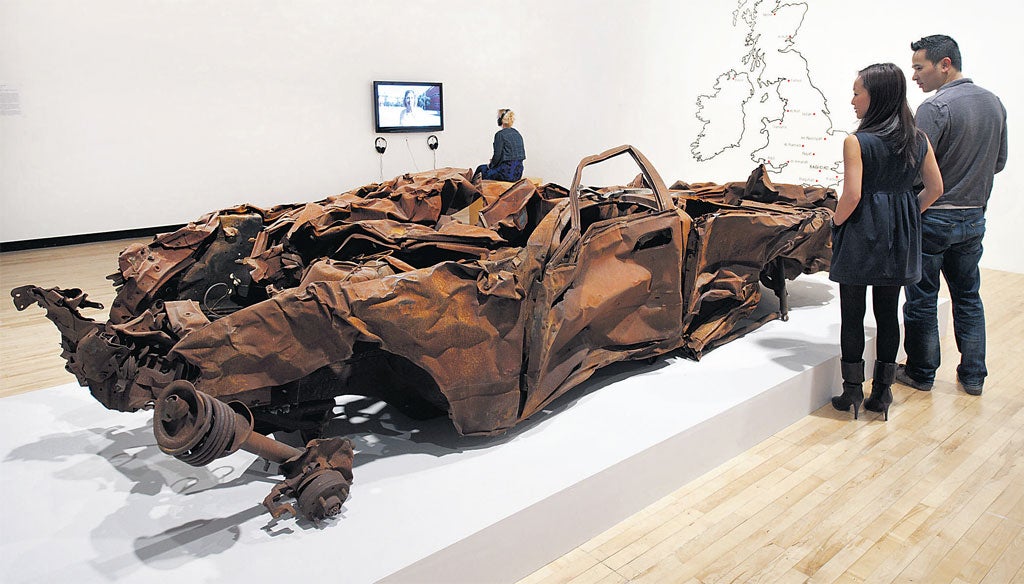Jeremy Deller: Joy in People, Hayward Gallery, London
These remains of war and protest are heavy with political engagement – but they're leftovers and hardly make a feast for the eyes

In 2007, London Underground approached Jeremy Deller with a commission to design a new cover for the Tube map. It was, with hindsight, a foolish thing to do. Deller is a militant cyclist: the image he produced for LU reshaped the familiar coloured plan of Harry Beck's map – Central Line red, District green, Circle yellow – into a bicycle. Sensing subversion, the company turned Deller's design down. You will find it towards the end of his retrospective at the Hayward Gallery, under the bald if accurate title Rejected Tube Map Cover Illustration.
It seems entirely possible that Deller's motto in art might be "Get on yer bike". This is not to suggest that the Turner Prize-winning conceptualist, 46 this year, has anything in common with Norman Tebbit. Their politics are of antithetical kinds. Tebbit's exhortation to the unemployed to ride off in search of jobs started from a belief that, in the words of his boss, there was no such thing as society – that it was every man for himself and the devil take the hindmost. To Deller, the bicycle means the opposite: environmental responsibility, mutual care, a grassroots society that defines itself against the State. The bike is the transport of the have-nots, pitched in perpetual battle against the haves.
One work in the Hayward's show, called The War on Terror, consists of photographs of signs around London announcing that "These railings are private property and any bicycles chained to them will be removed", or words to that effect. In Deller's lens, bicycles become two-wheeled weapons of mini-mass destruction, undermining the capitalist society that Tebbit and Thatcher simultaneously denied and endorsed.
All of which is to say that Deller is an unapologetically political artist, and that his politics are quite clear. His best-known work is The Battle of Orgreave (2001), the re-enactment by a thousand unemployed ex-miners of a violent confrontation during the 1984 miners' strike. This work, or its aftermath, has its own room at the Hayward, the walls hung with an installation – photographs, newspaper cuttings, protest badges, film footage of police breaking heads with batons – called An Injury to One is an Injury to All. Next door is It Is What It Is (2009), the burnt-out wreck of a bombed Iraqi car which Deller towed across the United States from New York to Los Angeles, stopping along the way so that people could examine and talk about it. Here in London, too, you can discuss the work with one of a number of volunteers – on the afternoon I went, a woman whose family had recently fled Baghdad.
It is tempting to think of Deller's crushed vehicle alongside those of the late US sculptor, John Chamberlain. Chamberlain's carefully mashed-up automobiles were a J G Ballard take on the American Dream, glossy, dangerous and erotic. Deller's It Is What It Is is what it is, a car destroyed by a bomb. But it also has an immanent backstory, which, like Chamberlain's, is to do with an American fascination with cars, and with the oil that feeds them. Deller's car is the opposite of a bicycle: it is a symbol of greed. Taking this particular wreck across Middle America, a region not known for its breadth of mind, was a brave thing to do.
There is a problem, though. Deller's motto as an artist isn't actually to do with bicycles; it is, "Art isn't about what you make, but about what you make happen". That's "happen" as in happening, performance art. True to his societal beliefs, his work mostly involves participation, collaboration.
This may take the form of unemployed miners or the Iraqi lady talking about her family, or the intently glum-looking volunteer who, in this show, sits on a black chaise longue under a wall-sign that reads I © Melancholy, or the women handing out free tea in a mocked-up Yorkshire snack bar. Deller, too, is a volunteer. As you walk into his reinvention of the Hayward's ground floor, you find yourself in the artist's teenage bedroom. Pull-out drawers, hand-labelled "Suburban Scenes 1989" and the like, open to reveal snapshots from what we assume are Deller's pre-superstar life.
This is inclusive art, art for everyone: folk art, if you like. Most of it, though, is leftovers, the remains of actions or processions or performances or happenings or lives led. I have no doubt that Deller feels what he feels passionately, nor that it would have been extraordinary to be at the battle of Orgreave or in the lorry that towed It Is What It Is across the United States. But if you subtract making from the equation of art and don't manage to be at the happening, then you are left with nothing much: relics, a sense of having missed the bus.
In spite of its title, Joy in People is joyless; intriguing, but, in the end, unsatisfying.
To 13 May (020-7960 4200)
Next Week
Charles Darwent joins Alighiero Boetti's arte party at Tate Modern
Subscribe to Independent Premium to bookmark this article
Want to bookmark your favourite articles and stories to read or reference later? Start your Independent Premium subscription today.

Join our commenting forum
Join thought-provoking conversations, follow other Independent readers and see their replies